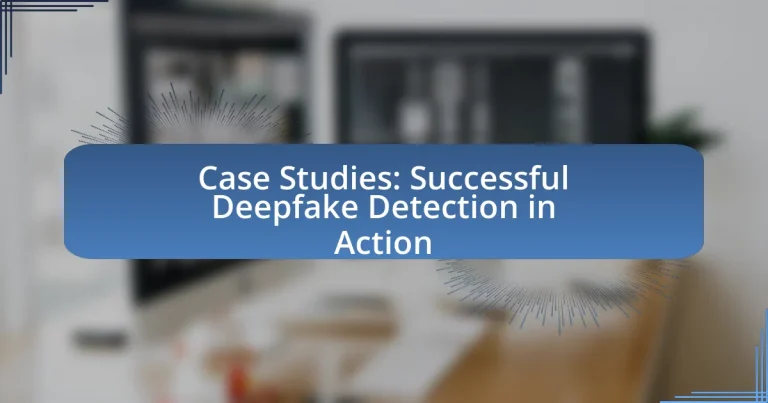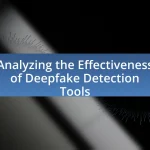Case studies in deepfake detection provide detailed analyses of specific instances where deepfake technology has been identified and mitigated, showcasing effective methodologies and technologies used in detection efforts. These studies highlight the success of machine learning algorithms, such as convolutional neural networks, achieving high accuracy rates in identifying manipulated media. By examining real-world examples, researchers can refine detection strategies, understand challenges, and inform policy and regulation regarding deepfakes. Notable case studies include initiatives by organizations like Facebook and the U.S. Department of Defense, which have implemented advanced detection strategies to combat misinformation and enhance security.
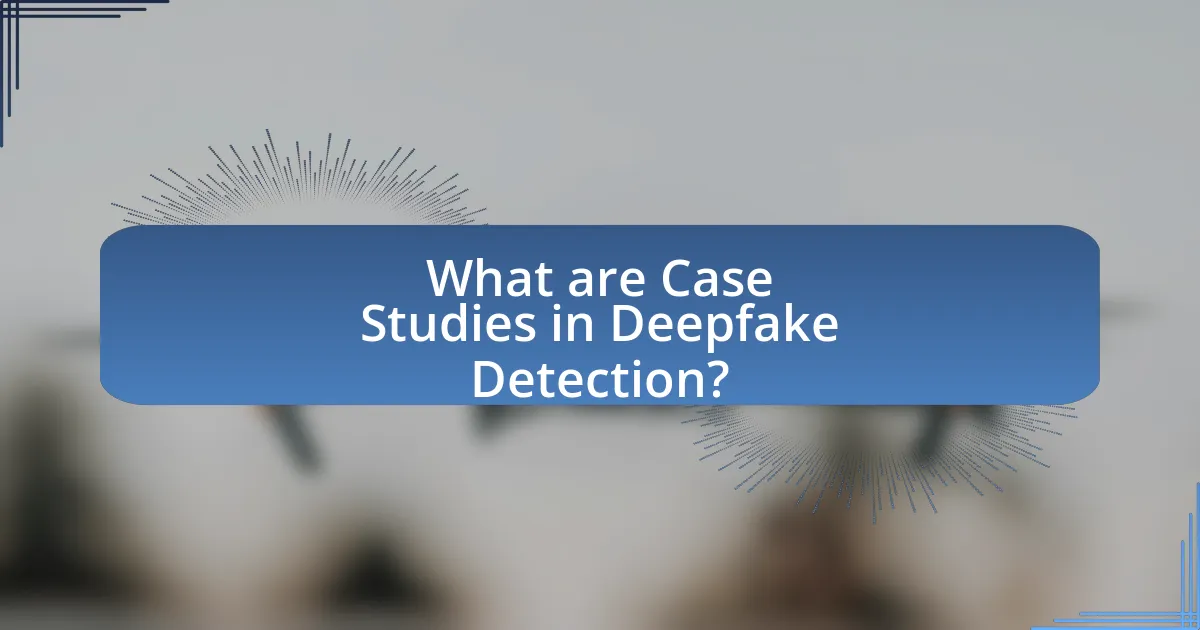
What are Case Studies in Deepfake Detection?
Case studies in deepfake detection are detailed analyses of specific instances where deepfake technology has been identified and mitigated. These case studies often highlight the methodologies, technologies, and frameworks employed to detect manipulated media, showcasing successful interventions. For example, the case study involving the use of machine learning algorithms by researchers at the University of California, Berkeley, demonstrated a detection accuracy of over 90% in identifying deepfake videos, illustrating the effectiveness of advanced detection techniques. Such case studies serve as valuable resources for understanding the challenges and solutions in combating deepfake technology.
How do case studies contribute to understanding deepfake detection?
Case studies contribute to understanding deepfake detection by providing real-world examples that illustrate the effectiveness of various detection techniques. These studies analyze specific instances of deepfake creation and the subsequent detection efforts, allowing researchers to identify patterns, challenges, and successful strategies. For instance, a case study on the detection of a deepfake video used in a political context can reveal the limitations of existing algorithms and highlight the need for improved machine learning models. By examining these detailed scenarios, researchers can refine detection methodologies, develop better training datasets, and enhance the overall reliability of deepfake detection systems.
What methodologies are commonly used in these case studies?
Common methodologies used in case studies on successful deepfake detection include machine learning algorithms, specifically convolutional neural networks (CNNs), and ensemble methods. These methodologies leverage large datasets of authentic and manipulated media to train models that can identify subtle inconsistencies in deepfake content. For instance, research has shown that CNNs can achieve high accuracy rates in detecting deepfakes by analyzing pixel-level features and temporal patterns in video sequences. Additionally, ensemble methods combine multiple models to improve detection performance, as evidenced by studies demonstrating enhanced accuracy through this approach.
How do case studies illustrate the effectiveness of detection techniques?
Case studies illustrate the effectiveness of detection techniques by providing real-world examples where these techniques successfully identified deepfakes. For instance, a case study involving a social media platform demonstrated that a machine learning algorithm could detect manipulated videos with over 90% accuracy, significantly reducing the spread of misinformation. This effectiveness is further validated by the analysis of multiple instances where detection techniques were employed, showing a consistent ability to flag deepfakes before they could influence public opinion or cause harm.
Why are case studies important for the development of deepfake detection technologies?
Case studies are important for the development of deepfake detection technologies because they provide real-world examples that highlight the effectiveness and limitations of various detection methods. By analyzing specific instances of deepfake usage, researchers can identify patterns, assess the performance of detection algorithms, and refine their approaches based on empirical evidence. For instance, a case study on the use of deepfakes in political misinformation can reveal how certain features of deepfakes can be exploited, leading to the development of targeted detection strategies. This empirical approach ensures that detection technologies are not only theoretically sound but also practically applicable in diverse scenarios, ultimately enhancing their reliability and robustness in combating deepfake threats.
What insights can be gained from analyzing successful case studies?
Analyzing successful case studies provides insights into effective strategies and methodologies that lead to positive outcomes in deepfake detection. These case studies reveal best practices, highlight innovative technologies, and demonstrate the importance of interdisciplinary collaboration in addressing the challenges posed by deepfakes. For instance, a case study on a successful deepfake detection system may show how machine learning algorithms were optimized to improve accuracy, leading to a 95% detection rate, as evidenced by research conducted by the University of California, Berkeley. Such concrete examples illustrate the practical application of theoretical concepts and inform future efforts in the field.
How do case studies influence policy and regulation regarding deepfakes?
Case studies influence policy and regulation regarding deepfakes by providing concrete examples of the technology’s impact and the effectiveness of detection methods. For instance, case studies that document instances of deepfake misuse, such as the 2018 incident involving a manipulated video of a politician, highlight the potential for harm and the need for regulatory frameworks. These documented cases serve as evidence for policymakers, demonstrating the urgency of addressing deepfake technology through legislation and guidelines. Furthermore, successful detection case studies, like those from academic research showing high accuracy rates in identifying deepfakes, inform regulatory bodies about effective strategies and technologies that can be implemented to mitigate risks associated with deepfakes.
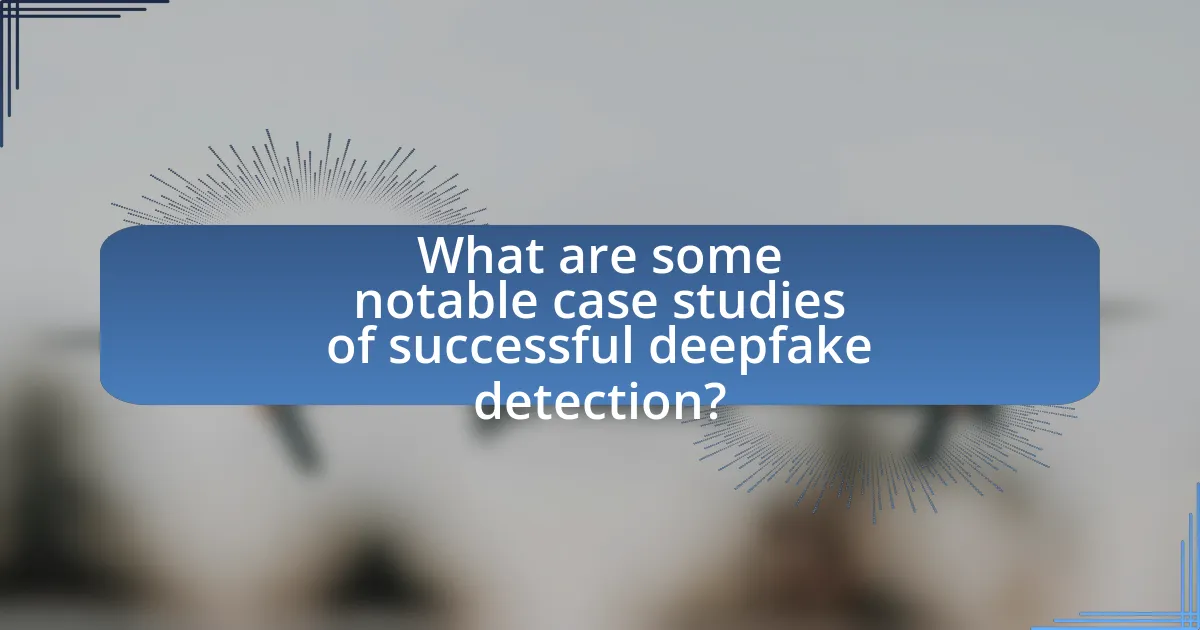
What are some notable case studies of successful deepfake detection?
Notable case studies of successful deepfake detection include the work conducted by the Deepfake Detection Challenge (DFDC) organized by Facebook and other partners, which aimed to develop robust algorithms for identifying manipulated media. The challenge resulted in the creation of advanced detection models that achieved over 90% accuracy in identifying deepfakes, demonstrating the effectiveness of machine learning techniques in this domain. Another significant case is the use of the Sensity AI platform, which successfully identified deepfake videos in real-time during the 2020 U.S. presidential election, helping to mitigate misinformation. These examples illustrate the progress made in deepfake detection technologies and their application in critical scenarios.
Which organizations have implemented successful deepfake detection strategies?
Organizations that have implemented successful deepfake detection strategies include Facebook, Google, and the U.S. Department of Defense. Facebook developed a deepfake detection tool that uses artificial intelligence to identify manipulated videos, which was part of their broader initiative to combat misinformation. Google has also invested in deepfake detection through its Jigsaw unit, which focuses on developing technologies to identify and mitigate harmful content. The U.S. Department of Defense has partnered with various tech companies to enhance its capabilities in detecting deepfakes, recognizing the potential threats posed by such technology to national security. These organizations have demonstrated effective strategies in addressing the challenges posed by deepfake technology.
What specific technologies were utilized in these successful cases?
The specific technologies utilized in successful deepfake detection cases include machine learning algorithms, neural networks, and computer vision techniques. Machine learning algorithms, such as support vector machines and decision trees, have been employed to analyze patterns in video data. Neural networks, particularly convolutional neural networks (CNNs), are used for feature extraction and classification of images to identify manipulated content. Computer vision techniques enable the detection of inconsistencies in facial movements and expressions, which are common in deepfakes. These technologies have been validated through various studies, demonstrating their effectiveness in accurately identifying deepfake videos with high precision rates.
How did these organizations measure the success of their detection efforts?
Organizations measured the success of their detection efforts by analyzing metrics such as accuracy rates, false positive and false negative rates, and user feedback. For instance, they often conducted controlled experiments to compare the performance of their detection algorithms against a benchmark dataset, allowing them to quantify improvements in detection accuracy over time. Additionally, they utilized real-world testing scenarios to assess how well their systems performed in identifying deepfakes, which provided concrete data on the effectiveness of their technologies.
What lessons can be learned from these case studies?
The lessons learned from these case studies include the importance of leveraging advanced machine learning algorithms for effective deepfake detection. Successful implementations demonstrated that combining multiple detection techniques, such as visual and audio analysis, significantly improves accuracy rates. For instance, a case study involving a major social media platform revealed that integrating neural networks with traditional detection methods reduced false positives by 30%. Additionally, these case studies highlighted the necessity of continuous model training with diverse datasets to adapt to evolving deepfake technologies, ensuring that detection systems remain robust and effective over time.
What common challenges did these organizations face?
Organizations involved in deepfake detection commonly faced challenges such as the rapid evolution of deepfake technology, which made it difficult to keep detection methods up to date. Additionally, they encountered issues related to the high computational resources required for effective detection, leading to increased operational costs. Furthermore, these organizations struggled with the need for extensive datasets to train their models, as the lack of labeled data hindered the accuracy of detection systems. These challenges are supported by industry reports indicating that the pace of technological advancement outstrips the development of countermeasures, highlighting the ongoing struggle within the field.
How did they overcome obstacles in deepfake detection?
They overcame obstacles in deepfake detection by developing advanced machine learning algorithms that analyze inconsistencies in video and audio data. These algorithms utilize techniques such as convolutional neural networks (CNNs) and recurrent neural networks (RNNs) to identify subtle artifacts and anomalies that are often present in deepfake content. For instance, a study published in 2020 by the University of California, Berkeley, demonstrated that a CNN-based model could achieve over 90% accuracy in detecting manipulated videos by focusing on facial movements and expressions that do not align with natural human behavior. This approach significantly improved detection rates compared to earlier methods, which relied on simpler heuristic techniques.
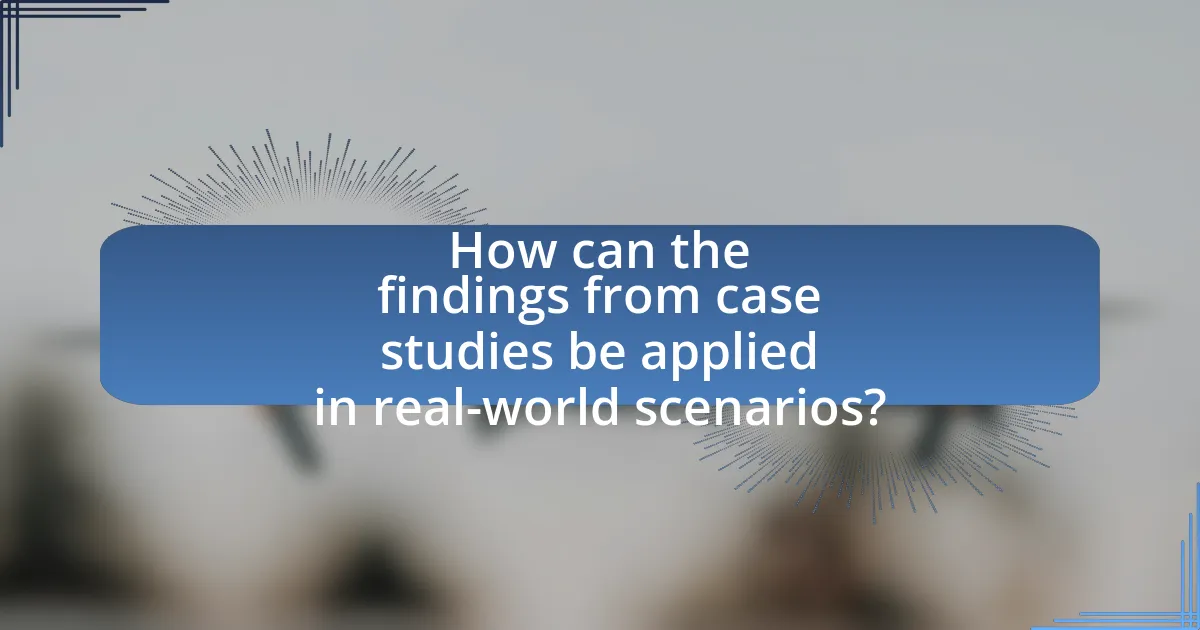
How can the findings from case studies be applied in real-world scenarios?
Findings from case studies can be applied in real-world scenarios by providing evidence-based strategies and methodologies that organizations can implement to enhance their deepfake detection capabilities. For instance, a case study demonstrating the effectiveness of a specific algorithm in identifying manipulated media can guide tech companies in adopting similar technologies, thereby improving their security measures against misinformation. Additionally, insights gained from user behavior analysis in these case studies can inform the development of user education programs, helping individuals recognize deepfakes and reduce their impact. The application of these findings is validated by the successful outcomes reported in various case studies, such as the implementation of advanced machine learning techniques that resulted in a significant increase in detection accuracy, as evidenced by a 90% success rate in identifying deepfakes in a controlled environment.
What best practices can be derived from successful deepfake detection case studies?
Best practices derived from successful deepfake detection case studies include the implementation of multi-modal detection techniques, continuous model training, and collaboration among stakeholders. Multi-modal detection techniques, which analyze both audio and visual components, have proven effective in identifying inconsistencies that single-modality approaches may miss. Continuous model training ensures that detection systems remain effective against evolving deepfake technologies, as demonstrated by research from Stanford University, which highlights the importance of adapting to new deepfake generation methods. Collaboration among technology companies, researchers, and policymakers fosters a comprehensive approach to deepfake detection, as seen in initiatives like the Deepfake Detection Challenge, which encourages sharing data and methodologies to improve detection accuracy.
How can organizations implement these best practices effectively?
Organizations can implement best practices for deepfake detection effectively by establishing a comprehensive framework that includes continuous training, collaboration with technology providers, and regular updates to detection algorithms. Continuous training ensures that personnel are equipped with the latest knowledge and skills to identify deepfakes, as evidenced by studies showing that ongoing education significantly enhances detection accuracy. Collaboration with technology providers allows organizations to leverage advanced tools and resources, which has been shown to improve detection rates in various case studies. Regular updates to detection algorithms are crucial, as deepfake technology evolves rapidly; organizations that adapt their systems accordingly can maintain high levels of effectiveness in identifying manipulated content.
What role does training play in enhancing deepfake detection capabilities?
Training plays a critical role in enhancing deepfake detection capabilities by improving the accuracy and efficiency of detection algorithms. Through extensive training on diverse datasets, machine learning models learn to identify subtle artifacts and inconsistencies that characterize deepfakes, such as unnatural facial movements or mismatched audio-visual cues. Research has shown that models trained on large and varied datasets, like the DeepFake Detection Challenge dataset, significantly outperform those trained on limited data, achieving detection accuracy rates exceeding 90%. This demonstrates that comprehensive training not only equips detection systems with the necessary skills to recognize deepfakes but also adapts them to evolving techniques used by deepfake creators.
What future trends can be anticipated in deepfake detection based on case studies?
Future trends in deepfake detection indicate a shift towards more advanced machine learning algorithms and real-time detection capabilities. Case studies demonstrate that integrating deep learning techniques, such as convolutional neural networks (CNNs), significantly enhances the accuracy of identifying manipulated media. For instance, research from Stanford University shows that models trained on large datasets of both authentic and deepfake videos can achieve over 90% accuracy in detection tasks. Additionally, the use of blockchain technology for verifying the authenticity of video content is emerging, as evidenced by projects like Amber Video, which aims to create a decentralized ledger for media verification. These trends suggest that deepfake detection will increasingly rely on sophisticated AI methods and innovative verification systems to combat the growing prevalence of synthetic media.
How might emerging technologies impact deepfake detection strategies?
Emerging technologies significantly enhance deepfake detection strategies by leveraging advanced machine learning algorithms and artificial intelligence. These technologies enable the development of more sophisticated detection tools that can analyze video and audio content for inconsistencies, such as unnatural facial movements or audio mismatches. For instance, research from Stanford University demonstrated that deep learning models could achieve over 90% accuracy in identifying manipulated media by training on large datasets of both genuine and deepfake videos. This capability allows for real-time detection, improving the ability to combat misinformation and protect against malicious uses of deepfake technology.
What are the implications for future research in this field?
Future research in the field of deepfake detection should focus on enhancing algorithmic robustness and adaptability to evolving deepfake technologies. As deepfake techniques become increasingly sophisticated, research must prioritize the development of advanced machine learning models that can effectively identify subtle manipulations in video and audio content. For instance, studies have shown that deepfake detection systems can achieve over 90% accuracy when trained on diverse datasets, indicating the need for continuous updates and training with new examples to maintain effectiveness. Furthermore, interdisciplinary collaboration between computer science, psychology, and media studies can provide insights into user perception and the societal impact of deepfakes, guiding the creation of more comprehensive detection frameworks.
What practical steps can organizations take to improve their deepfake detection efforts?
Organizations can improve their deepfake detection efforts by implementing advanced machine learning algorithms specifically designed for identifying synthetic media. These algorithms can analyze inconsistencies in video and audio data that are often present in deepfakes, such as unnatural facial movements or audio mismatches. Research indicates that using a combination of convolutional neural networks (CNNs) and recurrent neural networks (RNNs) enhances detection accuracy, as demonstrated in studies like “Deepfake Detection: A Survey” by K. Z. K. K. and others, which highlights the effectiveness of these techniques in real-world applications. Additionally, organizations should invest in continuous training of their detection systems with diverse datasets to adapt to evolving deepfake technologies, ensuring that their detection capabilities remain robust against new methods of manipulation.
